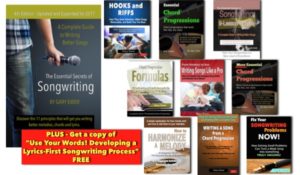For most songs in the pop genre, the bit that you really love will be some short, catchy fragment. That fragment — the hook — is the bit that you’ll remember forever about that song. Long after you’ve forgotten almost everything else, you’ll remember that hook.
 “Hooks and Riffs: How They Grab Attention, Make Songs Memorable, and Build Your Fan Base” shows you how a good hook can make the difference between songwriting success and failure. With great examples from pop music history.
“Hooks and Riffs: How They Grab Attention, Make Songs Memorable, and Build Your Fan Base” shows you how a good hook can make the difference between songwriting success and failure. With great examples from pop music history.
Everything else in the song has the duty of supporting and providing focus for the hook. That’s not to say that all the other bits don’t have their own intrinsic value, but without a doubt everything in a song that leads up to the hook whets the appetite of the listener and points to that hook as being the most important moment.
In many pop songs, the chorus hook gets placed right at the start of the chorus. There are other kinds of hooks, of course, if you count anything in a song that grabs attention and helps to make a song memorable. But the chorus hook is the bit you’ll keep humming and singing to yourself. If you like Adele’s music and you find yourself singing the line “Rumour has it…” over and over again, you know what I’m talking about.
So what does everything else in a song need to do in order to make a hook stand out and sound important? Here’s a short list of song elements that have the job of creating musical anticipation and excitement:
- The Verse Melody: A verse melody has a somewhat meandering quality; it can wander up and down, though over its length often in an upward direction. That gradual upward movement helps to build musical momentum and excitement, and causes the listener to want to hear the culmination of that upward movement: the chorus hook.
- The Verse Lyric: A good verse lyric sets the stage and builds a story, either literally or through implication. As each part of that story is described, the listener all the more wants to hear the emotional result of that story. That’s how chorus hooks become so powerful. They give us the ultimate summation of the emotion contained in the story (“Baby, you’re a firework!” “Raise your glass if you are wrong…” “Glory Days”)
- Pre-Chorus: A pre-chorus really has just one main purpose, which is to make a better connection to the chorus than would be possible without it. So almost by definition, a pre-chorus’s purpose is to do what a verse does (i.e., target the chorus), but to do so in a more obvious, specific way. If your pre-chorus isn’t building musical energy, it’s missing the main purpose of its existence!
- Instrumentation/Production: The choices you make in instrumentation have a lot to do with how we process musical momentum. A song’s verse will often offer a somewhat transparent instrumental treatment, so that when the chorus happens we feel excitement from the chorus hook by the sudden build-up of production and sound. Listen to Now, Now’s “SGL” for a great example of how instrumentation and production build and increase musical energy. We hear the culmination of that build at about 1’45” with the addition of vocal harmonies.
All songs need something that keeps people coming back. In most cases, that’s the hook. It would be a mistake to think that nothing else matters, though. The perfect partnership of all song bits makes the hook shine all the more.
And if you’ve got nothing else good in a song except a good hook, you’ve got a song with problems: a hook won’t solve everything. Remember, adding a hook to a bad song gives you a bad song with a hook. And that’s something that needs to be fixed.
 Written by Gary Ewer. Follow Gary on Twitter.
Written by Gary Ewer. Follow Gary on Twitter.
 Each eBook in “The Essential Secrets of Songwriting” 10-eBook Bundles shows you the fundamental principles that make great songs great. Comes with a Study Guide!
Each eBook in “The Essential Secrets of Songwriting” 10-eBook Bundles shows you the fundamental principles that make great songs great. Comes with a Study Guide!










